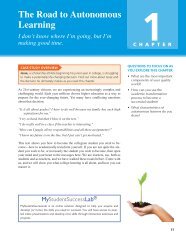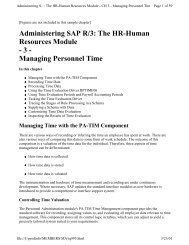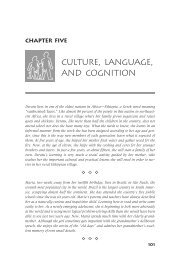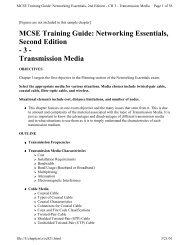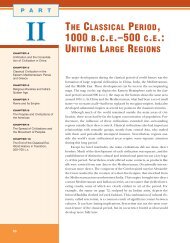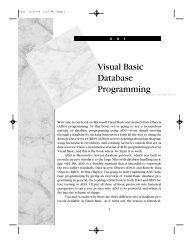SOCIAL PROBLEMS: A Down-to-Earth Approach, 8/e
SOCIAL PROBLEMS: A Down-to-Earth Approach, 8/e
SOCIAL PROBLEMS: A Down-to-Earth Approach, 8/e
Create successful ePaper yourself
Turn your PDF publications into a flip-book with our unique Google optimized e-Paper software.
our lives. Some of the impact is positive; the reduced labor costs, for example, lower what<br />
we pay for our clothing and cars. Some of it is negative, however, especially for the workers<br />
who lose their jobs and, after months of looking for work, end up with jobs that pay half of<br />
what they were earning. Mills used the term personal troubles <strong>to</strong> refer <strong>to</strong> things like this,<br />
<strong>to</strong> how the large-scale events of his<strong>to</strong>ry bring trouble <strong>to</strong> people’s lives. With all the publicity<br />
given <strong>to</strong> moving jobs overseas, “everyone” knows that this particular large-scale event<br />
causes a loss of jobs here. In most cases of personal troubles, however, we get so caught up<br />
in what is bothering us that we are unaware of how they are related <strong>to</strong> larger social forces.<br />
To better understand this connection between personal troubles and larger social forces,<br />
let’s apply the sociological imagination <strong>to</strong> Lisa and her grandmother. Lisa’s values reflect developments<br />
in our society that were not part of her grandmother’s consciousness when she<br />
grew up. Lisa’s views have been shaped by the women’s movement, which stresses that each<br />
woman has the right <strong>to</strong> make choices and <strong>to</strong> exercise judgment about her own body. From<br />
this perspective, which has become part of Lisa’s outlook on the world, a woman has the right<br />
<strong>to</strong> terminate her pregnancy. Abortion is simply one way that she controls her body. In the extreme,<br />
proponents of this view state that a woman’s right in this area is absolute. For example,<br />
she can choose <strong>to</strong> have an abortion at any point in her pregnancy, even if she is nine months<br />
along—without informing her husband if she is married or her parents if she is a minor.<br />
The sociological imagination also sensitizes us <strong>to</strong> the social forces that shaped Lisa’s<br />
grandmother’s point of view. When she was growing up, abortion was not only illegal but<br />
also considered so shameful that people did not even talk openly about it. Every woman<br />
was expected <strong>to</strong> become a mother, and almost all girls grew up with marriage and motherhood<br />
as their foremost goal in life. Careers and advanced education were secondary <strong>to</strong> a<br />
woman becoming a wife and mother. Marriage and motherhood were a woman’s destiny,<br />
her fulfillment in life. Without this, she was incomplete, not a full woman. Like Lisa’s grandmother,<br />
almost everyone also agreed that abortion was murder. Within this context, any<br />
woman who had an abortion had <strong>to</strong> keep her crime a secret. Some women who had abortions,<br />
frightened out of their wits, were taken <strong>to</strong> their destination blindfolded in a taxi. They<br />
endured kitchen-table surgery that carried a high risk of pos<strong>to</strong>perative infection and death.<br />
Yet neither Lisa nor her grandmother sees this finely woven net that has been cast over<br />
them, turning their lives upside down. Instead, the impact of social change hits them on<br />
a personal level: This is where they feel it, in their intimate and everyday lives. It affects<br />
what they think and feel and what they do—and, as in the opening vignette, how they<br />
relate <strong>to</strong> one another.<br />
In contrast, the sociological imagination (also called the sociological perspective) invites<br />
us <strong>to</strong> look at our lives afresh. The sociological imagination asks us <strong>to</strong> understand how<br />
the social context shapes or influences our ideas, attitudes, behaviors, and even our emotions.<br />
The social context encompasses his<strong>to</strong>rical periods and very broad events, such as the<br />
era in which we grow up, war, terrorism, and other his<strong>to</strong>rical turmoil. It also includes our<br />
social locations—the broad but narrower fac<strong>to</strong>rs that also influence our lives profoundly,<br />
such as our gender, race-ethnicity, religion, and social class. Then there are the smaller social<br />
locations in which we find ourselves, such as our age and health, our jobs and associates.<br />
Finally, there is the intimate level, our relationships with people who are close <strong>to</strong> us: our<br />
parents and siblings, our friends and children, our wife, husband, or lover. Together, these<br />
many levels combine <strong>to</strong> make up the social context that shapes the way we look at life.<br />
THE SIGNIFICANCE OF <strong>SOCIAL</strong> LOCATION. Table 1-1 illustrates how significant social location<br />
is in influencing whether a woman has an abortion. From this table, you can see<br />
the difference that age, race-ethnicity, marital status, and length of pregnancy make. Look<br />
at age: This table shows that half (519 of 1,000) of girls under the age of 15 who get pregnant<br />
have an abortion. Those who are the next most likely <strong>to</strong> have abortions are other<br />
teenagers and women in their early 20s. The rate of abortion keeps dropping with age<br />
until women reach their 40s, when it increases sharply. Now look at the influence of raceethnicity.<br />
As you can see from this table, African American women are twice as likely <strong>to</strong><br />
have abortions than are white women. The most striking difference, however—which cuts<br />
across age and race-ethnicity—is marital status: Unmarried women are six times more likely<br />
than married women <strong>to</strong> obtain an abortion.<br />
4 CHAPTER 1 HOW SOCIOLOGISTS VIEW <strong>SOCIAL</strong> <strong>PROBLEMS</strong>: THE ABORTION DILEMMA



